Honouring Canadian Arctic Scientist Martin Bergmann
I must say that I have never known anyone who has posthumously had an extinct fish species named after them. But, if it were to be anybody – that I had the pleasure of meeting through my travels and work as a journalist in the Canadian Arctic – it had to be Martin (he went by “Marty”) Bergmann.
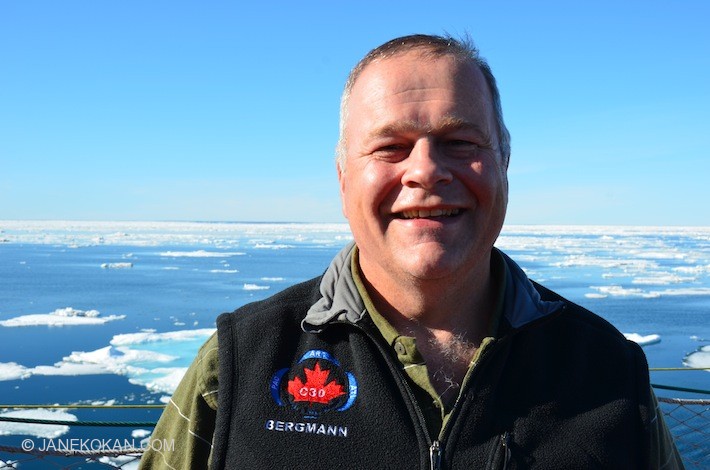
Martin Bergmann aboard the Louis S. St-Laurent, Canada’s largest icebreaker
It is not uncommon to have newly discovered living species named after famous individuals. In July 2012, Reggae star Bob Marley (who died of cancer in 1981) was awarded a posthumous honour when a new species of crustacean – a blood-sucking parasite that attacks fish – was named after him. Even living individuals are bestowed the honour of having a species named after them. Did you know that U.S. President Barack Obama has an orange-coloured lichen named after him?
Sadly, Marty perished in an air crash in Resolute Bay, Nunavut, on August 20, 2011. He had an Arctic mission to attend to – which involved important science and military meetings as well as keeping people perpetually interested – including politicians, academics and Arctic students – in Canada’s North.
Marty deeply loved his wife and four children. Everybody knew that. Just as he was extremely passionate about Arctic science. He cherished everything Arctic and now his legacy will live on.
In a recent news release from Drexel University in Philadelphia, researchers have named a new fossil fish species, discovered on Ellesmere Island in Nunavut – Holoptychius bergmanni – in honour of Marty Bergmann. Dr. Ted Daeschler and his colleague talk about the new extinct species in the latest issue of the ‘Proceedings of the Academy of Natural Sciences of Philadelphia.’
The U.S. researchers have identified the ancient fish species that’s around 375 million years old as a new, metre-long predator from Paleozoic Canada. Dr. Daeschler states that during the Devonian period, which is part of present Arctic Canada, it was survival of the fittest: “We call it a ‘fish-eat-fish world,’ an ecosystem where you really need to escape predation.”
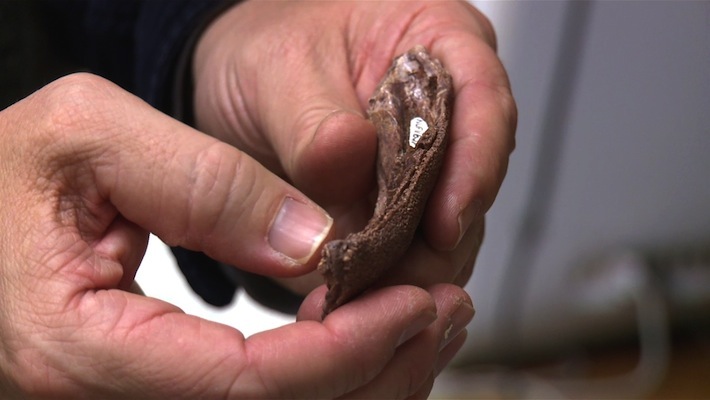
Dr. Ted Daeschler holds a lower jaw fossil of Holoptychius bergmanni. Credit: Academy of Natural Sciences of Drexel University
Jason Downs, a researcher from Drexel University, explains how the recently discovered extinct Arctic fish species got its name: “We decided to choose Martin Bergmann to honor him, not ever having met him, but with the understanding that his work with PCSP [Polar Continental Shelf Program] made great strides in opening the Arctic to researchers. It’s an invaluable project happening in the Canadian Arctic that’s enabling this type of work to happen.”
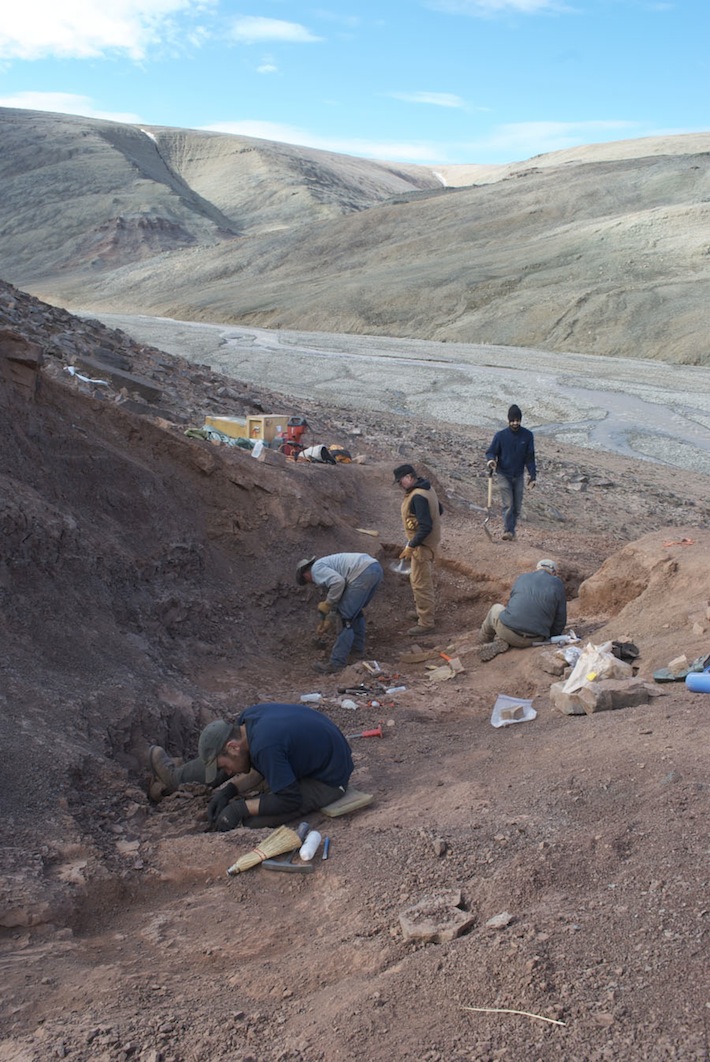
Excavating Devonian fossils in Nunavut, the Canadian Arctic. Credit: Academy of Natural Sciences of Drexel University
Bergmann and his people assisted the U.S. research team with expedition logistics including challenging and complex flight operations to carry supplies and research personnel to remote research sites on Ellesemere Island, Nunavut.
The last time I saw Marty – alive – was on July 20, 2011, aboard Canada’s flagship icebreaker, the CCGS Louis S. St-Laurent. I interviewed him outside on the helipad. He was excited to be on-board, especially when it came to science and putting like-minded people in contact. Everybody from the lads in the engine room to Captain Andrew McNeill adored him and respected the work he was doing. Sadly, a month later, on August 20, 2011, I received the terrible news that First Air flight 6560 crashed into the hillside opposite Resolute Bay airport in Nunavut. Marty was one of the 12 people killed in the crash. (Miraculously three people survived the impact.)
I know he would be pleased to learn that he will be eternally connected to an ancient fish species – Holoptychius bergmanni – named after him. (In 2012, Marty, had an Arctic research vessel named after him.)
I first met Marty in Resolute Bay in the summer of 2010, where he gave me a detailed tour of the Polar Continental Shelf building. Smiling and grinning ear to ear, he said, “I am Marty. Welcome to Resolute Bay. Welcome to the Arctic. Thank you for your interest.”
He was a brilliant networker and loved to talk to everybody. I mean everybody. He facilitated the visits of scores of science and geology professionals to the North. He also managed logistics for Arctic ocean science aboard the Canadian Coast Guard fleet, including Canada’s biggest icebreaker, the CCGS Louis S. St-Laurent.
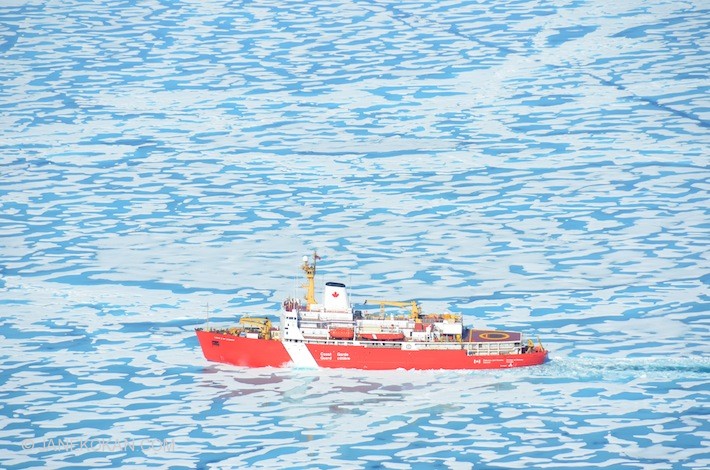
The CCGS Louis S. St-Laurent, Canada’s largest icebreaker, navigating the Northwest Passage
Here are some excerpts from an interview I conducted aboard the “Louis” one month before Marty’s untimely death.
Question: Could you describe the job that you do please?
MARTIN BERGMANN: “I’m Marty Bergmann. I’m the director of the Polar Continental Shelf Program of Natural Resources Canada. And I spent almost thirty years in the Arctic being involved directly with field work and field work logistics. I spent 24 years with the Department of Fisheries and Oceans as a biologist first, working out of Resolute in Nunavut in the High Arctic and then in 1990 I left field work and did management work in Fisheries until 2007, when during the International Polar Year the opportunity to manage the logistics around aircraft where I had been managing logistics around vessels became an opportunity for me to move to another area and to learn some more about the North.”
Question: What exactly is the Canadian Coast Guard icebreaker the Louis S. St-Laurent’s mission up here in the Arctic?
MB: Well, the Louis St-Laurent’s mission this year is multi-purpose as normal. The Coast Guard ships that are working up here in the Arctic have typically had that role. So, from a science perspective – aboard the ‘Louis’ – this year’s primary mandate – is to complete the work that they had initiated a few years ago, which is the United Nations Law of the Sea work. So they are going to be joining up with the [U.S.] Coast Guard Ship, the Healy and conducting survey work out in the Beaufort Sea. Enroute to getting there, the Department of Oceans and Fisheries is working as the lead agency in support of their oceanographic studies of the region between Canada’s three oceans.

Question: Is the Arctic “melt” something we should all be worried about?
MB: The issue is, there’s nothing really new about melting ice. The ice has had this dominance of different stages, over millennia. However, I think what is of biggest interest, is that today, based on the data that we have over the period of collecting scientific information from this part of the region, we realize that this is as reduced an ice profile as we’ve ever had. So since we started collecting data scientifically on this planet, as humans, we haven’t had this little amount of ice in the Arctic. So it’s exciting to be part of a program, to study it.
Question: The Arctic is in the news every day, why do you think this is?
MB: I think the Arctic region generally has gained in popularity in this country as in Canada and around the world. And I think there are a variety of reasons why this is actually happening. One is that the climate changes that are going on here, make it a very interesting place for science to come and understand what’s happening from an environmental, global perspective.
So the science brings stories. The stories bring thinkers and in our country, where we are looking at developing the resources, effectively and environmentally, around this country, the North is a little bit more accessible. With new technologies and a lesser ice regime to consider to worry about, we are able to mobilize more people and more discussions in this region.
Question: Is the Canadian Arctic becoming a much busier place these days?
MB: The Arctic is becoming busier because more scientists are coming to the North to do their work. Ever since [the launch of] the International Polar Year – where Canada and many other countries, invested new funds to support Arctic research – it – along with other initiatives in Canada and elsewhere – have created a greater interest among young scientists to work up in the Arctic. So, yes it is a busier place.
Question: Are we seeing more geological activity, more mining activity?
MB: There’s greater interest, with the work being done under the geo-mapping for the energy and minerals program. This is providing good, basic information about what the geology is [all about] in this part of the world. And that will help decision makers on an industry and government perspective, to make choices. So from the point of view of where we are at with logistics up in the North, where it is complicated, where there’s no rail, there’s no road. Sealift is still an activity that occurs once per year in most of the [Northern] communities. Logistics is difficult to arrange for. It is expensive to transport equipment from the South. Either marine or air costs are an added cost to any product that is here.
So co-ordination is really important and safe logistics is extremely important. And the organization that I am responsible for, basically, provides the wings for scientists to move about in the North by providing aircraft and field support systems to get them to their various locations. We only have a few communities in the North, just over 30 communities, there’s 110,000 people who live in the North, an area the size of Europe. And the work that needs to be done, on these multitude of islands, this is the longest coastline in the world, for any nation requires well thought through, well planned logistics, which uses specialized equipment to get you in and out of these areas, where there are no airports, there are no runways. So that’s our job too, to help Canadians and Canadian science and international science, achieve that.
Question: Some experts are saying that the Northwest Passage is becoming busier with more shipping and tourism traffic?
MB: Well maybe that’s the point, that there aren’t that many ships up here [now]. And there may be a few more ships over the next few years as the ice weakens and allows for longer periods of time for them to operate. But we are not looking at any major highway up here either. These are still complicated waters to be traveling in. You need specialized ships to do this work. It’s not as if you can travel in the Canadian Arctic without something like an icebreaker to support you at this time of year [summer].
Question: Is this an exciting time to be involved in Arctic research and exploration?
MB: This is a tremendously exciting time to be involved in Arctic work. You can’t pick up a newspaper in this country and not see some article about the Arctic. To me – that to have a discussion amongst Canadians and amongst people around the global biosphere – about the North is extremely important. So yes, I am very pleased to see, all this attention to the North and we need to continue to give and provide opportunities for people to see it. Canada is fortunate in that is has assets and it has communities in the North and we hope that more people will come to Canada and come to the Canadian Arctic and see it first hand.

MB: The underlying and the underpinning of any discussion about the Arctic is going to be the data and the information and science around it. So, if we are actively collecting information about the North, whatever decisions we will make, will be based on good information not hypothesis.
Question: Can you comment on the Inuit that live up North full-time and your relationship?
MB: Yeah, sure. So we’re very fortunate when working in the North as scientists; the best observers of the environment are always the people that actually live here. And so Northern people, intensely curious about their environment, and attune with their environment, are very similar to the curiosity driven science that we see and the applied science that’s needed out in this area. So there’s a natural synergy around that. People like being out on the land, or being out on the ice here, and collecting information.
Science is about observing. And Northern people and the [Canadian] Rangers that are often supporting scientists when they go out in the field, results in a lot of cross-pollination of ideas. By having the Rangers and Northern communities who are here all the time, to provide information to the research that often comes from different parts of the world, and so they are able to tie the pieces together from one month to another and from one year to another. So there’s an excellent relationship between the two groups.
Question: Standing here on this icebreaker and looking at the dizzying, vast Arctic landscape of the Northwest Passage, what goes through your mind?
MB: I find immense beauty in this part of the world. And you can find ice and water and land everywhere, but I think the perspective of 24 hours of sunlight is an eye-opener in summer. And 24-hour darkness in winter. The fact that we are thousands of kilometres away from cities, anywhere in the world, makes this a very, very special place. The fact that I’ve been lucky enough over the years to have been here and shared information with others, makes it very special. One of my most significant activities over the last number of years, was trying to create an environment where more people get an opportunity to see the Arctic. And this is something I want to share with as many people as possible.
Question: Is the federal government doing a good job of investing in the Canadian Arctic?
MB: That’s a good question. I think the issue is that we as a country, that our investment in the North is extremely important. And if we want to bring – the best minds, in Canada and elsewhere to this area to do these studies – we are going to have to make sure that they have good safe logistics, cost effective logistics so it isn’t crippling for somebody to come from the South and to come to the North and do their work. And we need to have sufficient funding in the science community to allow that to happen.
I think every Canadian, should get an opportunity to see the North, just as we spend time traveling around the world and seeing the Taj Mahal and the Eiffel Tower, I think this is one of the wonders of the planet. And we should try to have every Canadian, and every person that’s possible, to see the North in it’s true nature and form.
Question: What do you think about the work of the Arctic Council so far?
MB: I think the Arctic Council is doing a really good job of creating a table where the nations, the Circum-Arctic nations and the indigenous people can talk about the issues of the North and invite the rest of the world to the table in discussions. I think this is one of those areas on the planet, where we are working very co-operatively and we need to continue to do just that.
Question: What does Arctic sovereignty mean to you personally?
MB: My personal view is that science and sovereignty are the same thing. So if you have people learning about your country, that’s an important thing. So if you are out here as a tourist, if your are out here as a businessperson, if you are out here as a scientist, these are all positive things. The Arctic isn’t one of these secrets that we need to keep from the planet. This is something that we need to share in a positive way, in a positive light.
In memory of Martin Bergmann and science
Wherever he may be – in the Arctic skies or seas – Marty Bergmann’s legacy lives on. He would be chuffed to learn that he now has a 375 million-year-old Devonian fossil fish named after him. In any event, the scientists from Drexel University, intend to return to Ellesmere Island, Nunavut, for another field expedition in the summer of 2013, to search for more fossils. Marty will be checking out their research.
Marty Bergmann will forever be remembered.

Curious polar bear in the Northwest Passage, Nunavut, Canada


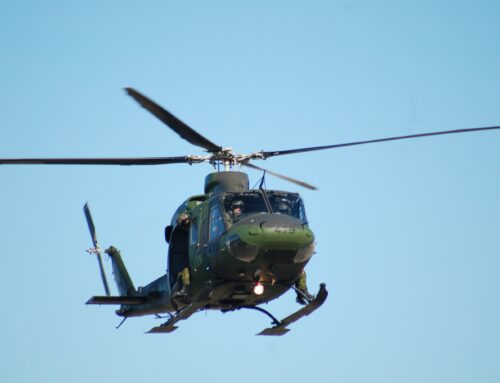
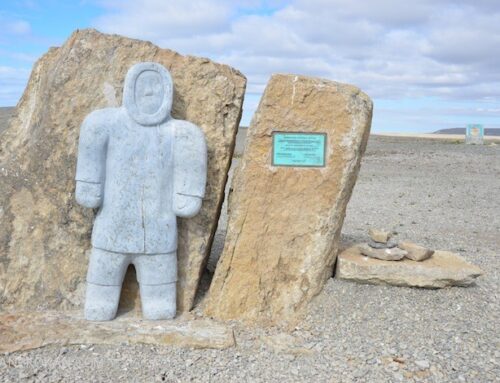
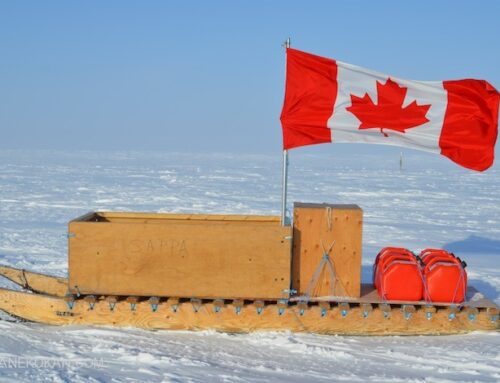
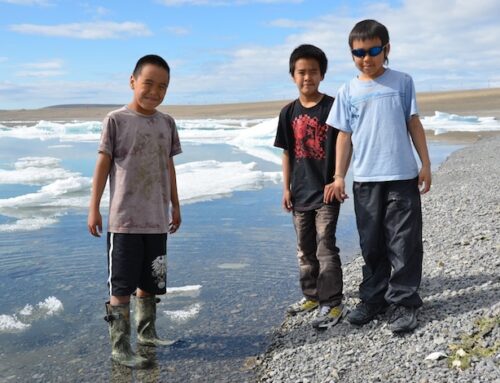
Enjoyed reading about our Canadian Arctic; all Canadian should be proud to have people like Marty, who are opening the canadian north and facilitating the access to this beatiful Canadian teritory.
We are still waiting for the TSB’s report on the crash of the plane that killed Marty Bergmann. That report has been delayed until sometime in 2014. The airport was under military control at the time. Ironically, a military exercise simulating the crash of a plane like the one that did crash, killing Bermann and others, was under way at the time.
”We call it a ‘fish-eat-fish world,’ an ecosystem where you really need to escape predation.”